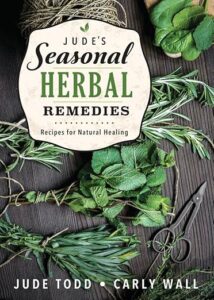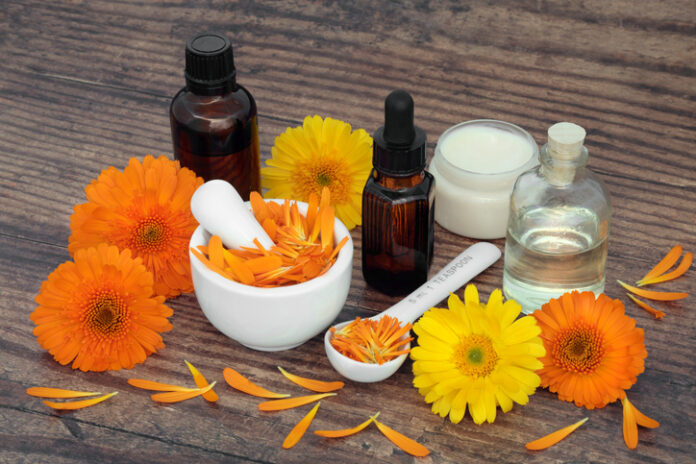Ah, summer! We all love this time of year, with the sun and plenty of outdoor activities to enjoy. But those outdoor barbecues, gardening stints, and a little too much sun can present us with many different skin issues. Luckily, we have a flower that can help us out with all the issues we come up against. And, it isn’t just for summer—you can actually have and use it any time of year by making remedies with it to have on hand. This herb loves and cares for skin specifically. What is this little miracle? It is the sunny orange and yellow Calendula flower (Calendula officinalis).
Calendula, also known as Pot Marigold or Mary Bud, is an always welcome addition to our garden just because it is so versatile and healing. It takes care of wounds, cuts, and scrapes; soothes sunburn; enhances hydration and is helpful for aging skin; is great for rashes and eczema; and is helpful with acne. What better skin care product to have in your medicine cabinet and one you can make for pennies? I’ll tell you a secret: this herb, a member of the daisy family and closely related to the marigold, in my opinion, is better to use than any expensive cream you can buy at the store. Why is it so healing? Suitable for all skin types, it contains compounds such as flavonoids, triterpenoids, and saponins; these compounds reduce inflammation as well as increase oxygen and blood flow, helping to speed healing and hydrate. Additionally, this powerful flower has antifungal and antimicrobial properties to banish infections.
Although you can purchase dried Calendula to use and have on hand, this particular plant is super easy to grow yourself, whether in your garden or a pot on you back patio. You can directly sow the seeds after any danger of frost has passed. Most often, it will reseed itself after you get it going. If you want a continued bloom all through summer until the arrival of autumn frosts, you can sow a couple of times, 2-3 weeks apart. It likes a sunny spot with rich and well-drained soil (it hates to be water-logged, so keep that in mind). When the plant begins blooming, cut them, which encourages more blooms. To dry, spread the heads and petals face down on clean dishtowels or newspapers and let air dry in a cool, dark spot. They will be dry in one to two weeks, at which time you can put them in brown paper bags to set aside until you need them. Although not ideal, you could also use a dehydrator for a quicker turnaround. It isn’t recommended to oven dry. Once you have your Calendula petals (whether procured through purchasing, picking fresh, or drying them yourself), you are ready to turn them into something useful.
Here are five different ways you can make some remedies and get prepared to banish your summer skin woes.
- Tea Wash: As an anti-inflammatory itself, a simple tea wash is great for itchy insect bites. It will take away the itch and soothe the bite, reducing any swelling. For sunburn, make sure to make a strong tea using a soaked cloth to lightly sponge the area several times a day. You can make the tea wash ahead of time and keep on hand in the refrigerator; it will keep easily for about a week, and then after that you’ll want to refresh it with a fresh batch. Here’s how to make it: Take a cup of fresh flowers or ½ cup dried and pour 2 cups boiling water over it, covering it to let it cool. Strain it and compost the used plant material. Pour the healing liquid into a closed container and label it. Then, any time a skin emergency comes up you are ready with a nice cool compress.
- Tea: Drinking Calendula tea is not only refreshing but it is good for you, too. Since it is anti-inflammatory, it helps from the inside out by helping with digestion, which in turn helps the skin. The tea has a peppery, floral, and slightly bitter taste that you can enhance with some good honey. To make the tea, use 2-3 tablespoons of dried Calendula, or a small handful of fresh blooms, and place in a large mug. Pour 1 cup boiling water over and allow to steep for 5-6 minutes. Strain, add your honey to taste, and drink up!
- Tincture: A tincture is a concentrated version of the healing compounds of an herb and is very easy and handy to have around. Tinctures last up to 5 years. No need to brew up a tea—you have all the healing you need in a dropper right on your shelf. What can you use it for? Cleanse the lymphatic system by adding about 46 drops to your tea or beverage for a week. Add a few drops to unscented face lotion to get rid of acne eruptions, for rashes, and other irritations. Dilute a few drops into a glass of water as a mouthwash to soothe sore or infected gums. You can also add a few drops under the tongue several times a day to help ease menstrual pain. Or you can add a few droppers full to your bath to soothe dry, itchy skin or other skin conditions. Really, the sky is the limit on helping your skin with this tincture!
You will need a dark glass bottle with a dropper for handy storage and dosing. But really, any small, dark jar will do in a pinch—you can measure out your dosage with a measuring spoon. To make the tincture, take a pint mason jar and make sure it is sterilized. Add to the jar ½ cup dried Calendula petals or 1 cup fresh. Pour in a good-grade vodka, covering the blooms completely. Close tightly and shake. You will want to let it steep for about 2-3 weeks in a cool, dark place. When it has fully steeped, strain it out into your container (don’t forget to squeeze all the goodness out of the plant material!). You now have a tincture to keep on hand for whatever need you have.
- Salve: Have a burn? Want to hydrate aging skin? Have eczema or psoriasis? Why not make up a soothing calendula salve? It will last up to a year if stored in a cool, dark place. Recipe: First make an infused oil (or purchase ready-made calendula oil), then make the salve and have small tins or jars clean and ready to pour your mixture into.
Infused Oil: 1 cup dried Calendula flower, 1 ½ cups carrier oil (I recommend olive or sweet almond oil). Put the flowers into a jar about ¾ full. Cover with the carrier oil of your choice. Cap and let the oil infuse for 4-6 weeks out of direct sunlight. Strain with a fine sieve or cheesecloth. Squeeze the oil from the flower and compost the expended plant material. You now have Calendula oil.
Calendula Salve:1 cup of infused Calendula oil, 1 ounce beeswax, 6-8 drops essential oil of your choice if you wish (lavender is good for the skin and works well here). Place a heat-safe bowl over a pot of simmering water. Gently heat your infused oil and add the beeswax to melt. Use a bamboo skewer (or something else easily discarded) to stir. When completely melted, remove from the double boiler and add 6-8 drops of an essential oil of your choice. Immediately pour into containers to set up (usually several hours to cool).
- Balm: A balm is similar to a salve, yet it is firmer. It’s great for using on rough, chapped hands or for a soothing lip balm for dry cracked lips. Here’s what you will need: 2 teaspoons of Calendula-infused oil, 1 teaspoon of beeswax, 2 drops of vitamin E oil, and five drops of the essential oil of your choice (for a pleasant taste try peppermint, lemon, or sweet orange essential oils). First, gently heat the infused oil and beeswax like you did the salve, until melted. Remove from heat and add your essential oils and vitamin E. Stir completely, then pour into little tins or jars to cool.
And there you have it! You can now enjoy some of summer’s activities without a care, because you have on hand a powerful ally to address any skin situation you encounter.
ABOUT THE AUTHOR:
Carly Wall, certified aromatherapist and author of previous titles on the subject of herbs and aromatherapy, is Jude Todd’s daughter. Upon discovering the manuscript her mother was working on before she passed away, Carly compiled and edited the book to celebrate and share Jude’s final work with her many readers. Carly’s blog can be found at Carlys-Herbal-Adventures.com.
Here’s a look at Carly’s latest book: Jude’s Seasonal Herbal Remedies (with Jude Todd)
 Seasonal Remedies for Year-Round Health
Seasonal Remedies for Year-Round Health
With nearly 300 recipes for teas, tinctures, tonics, and other treatments, this collection of restoratives ensures you are prepared for almost any ailment.
Following the success of beloved classic Jude’s Herbal Home Remedies, Master Herbalist and Naturopathic Doctor Jude Todd began assembling recipes for a new compendium. After Jude passed away, her daughter Carly Wall found and edited her unfinished manuscript, cultivating it into a profound continuation of Jude’s legacy. The resulting guide, organized by season, walks you through natural medicine for many conditions, such as:
• Acne • Cough • Cramps • Depression • Eczema • Gout • Headache • Menopause • Pneumonia • Sore Throat • Tension • Toothache
Jude’s Seasonal Herbal Remedies also offers practical advice for growing your own herbs and harnessing their healing properties in personal care products like shampoo, deodorant, and bath salt. With some of Jude’s most impressive recipes and nearly fifty plant illustrations, this book will enrich your herbalism practice with a wealth of knowledge Jude honed over decades of experience.
COPYRIGHT (2024) Llewellyn Worldwide, Ltd. All rights reserved.






